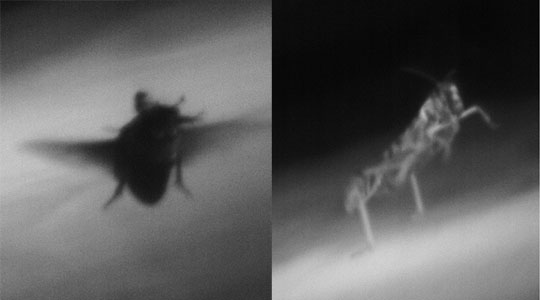High-resolution wing beats
New video technology makes it easier to observe moving insects
Retroreflectors attached to the back of a beetle or grasshopper ensure that a camera can always follow the animal quickly as it moves. Photos: Tat Thang Vo-Doan
A finger strokes carefully over the insect's back - there’s a brief twitch, and suddenly it jumps high. “Grasshoppers quickly cover a big distance when they jump,” says biologist Professor Andrew Straw from the Department of Neuro- and Behavioral Biology at the University of Freiburg. The camera follows the animal in sharply-focused close-up. “With our system, we can produce videos in which we can see exactly which direction the insects are looking in and how their antennae and legs move, even when they travel several meters,” Straw says.
Long distances in a short time
Insects know exactly where certain flowers are and where their nest is located. Their memory of places works through their sense of sight or smell. In order to be able to investigate their navigation behavior, the biologist from Freiburg therefore not only needs to know their position: he also needs to include their exact body movements and details such as the animals' line of sight. This requires high-resolution images of the animals as they move around in their natural world. "Until now, there was no technology to take such pictures in a larger environment," says Straw.
When insects move, they cover long distances in a short time. At the same time, they move their small bodies at lightning speed. Even a high-resolution camera has trouble getting unblurred photos of moving insects. “If we point it at a large area and a small bee flies through, it is just a blurred spot on the picture. That's because the camera is still and the animal is moving,” says Straw. Scientists have been using radar systems to study how bees navigate. “This allows us to track their position - but we don't learn anything about their bodies,” Straw explains. Other researchers film individual flowers in high resolution and wait until a bee goes to just that place - but then there is no data on how it got there. In order to understand an insect's navigational behavior, you need its movement data and high-resolution images at the same time.

A grasshopper jumping, a beetle in flight: The new system delivers high-resolution images showing in detail how the insects move.
Photos: Tat Thang Vo-Doan
Always on the insect
This is where the new system comes in. Straw developed it with a member of his working group, engineer Dr. Tat Thang Vo-Doan. It is based on the idea of filming the animal directly rather than a specific location. “If we keep the camera pointed at the insect, it focuses on it - and only the background is blurred,” says Straw. To constantly track the insect's position, Vo-Doan and Straw attach a reflective ball to its back and point a laser at it. “This retroreflector is made of the same material as a road sign,” explains Straw, “If light shines on it, it shines brightly because the light comes back directly.” The reflected light falls on four photodiodes and two mirrors that the diodes can move. If the light does not hit the center directly, the animal has moved - then the angle of the mirrors changes automatically and corrects the light beam. “Photodiodes are extremely fast - the mirrors are therefore always precisely aligned with the insect,” Straw says. At the same time, the scientists point a high-resolution camera at the mirrors. This enables them to follow the animal over a long distance and record the movement of its body parts on video.
Useful in other areas, too
So far, the system works best with nocturnal animals or under controlled light conditions in the laboratory. “We are developing it further so that it can also be used outdoors in daylight,” says Straw, who is also considering using it in other species. “Bats can carry a larger retroreflector - with them, observations over greater distances would be possible.” Vo-Doan and Straw's system is not only of interest to biologists, but could also be useful for engineers developing optoelectronic systems. “In small flying micro-robots, for example - We can track their position and film them to find out exactly what's happening to them,” says Straw, “Our system could also supply them with energy via a laser, which is one of the main problems in the development of that type of robot.”
Sarah Schwarzkopf
Video: Millisecond Insect Tracking System


